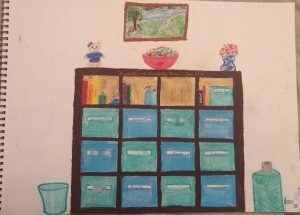 While walking in to Walmart, excited about wearing pants for the second day in row after fifteen years of skirts and dresses, an almost untraceable yet personally paralyzing smell filled the air, taking me back to Saturday afternoons at Walmart with my mentor during college. I saw the grocery list as she progressively added to the growing price tag, remembered the soda we would purchase when we first entered every week, and yet felt the fear of the pending conversations laced with guilt, waiting for her husband to find something else to yell at me about in the afternoon.
While walking in to Walmart, excited about wearing pants for the second day in row after fifteen years of skirts and dresses, an almost untraceable yet personally paralyzing smell filled the air, taking me back to Saturday afternoons at Walmart with my mentor during college. I saw the grocery list as she progressively added to the growing price tag, remembered the soda we would purchase when we first entered every week, and yet felt the fear of the pending conversations laced with guilt, waiting for her husband to find something else to yell at me about in the afternoon.
All I needed was to get-in and get-out with a belt in about fifteen minutes before church, not spend time processing through the brokenness, longings and regrets. Unfortunately, emotions, trauma, anxiety, and depression do not care about the current situation nor the infinitely growing list of things to accomplish in a day. They do not care that one must continue to function in a work or home environment, and they spare no limit, despite the inability to deal with them in the present moment. Because of this, it is important to have a way to purposefully store these intricacies for a time, in order to deal with them when the atmosphere and circumstances are more appropriate and manageable. Hence, we have the Protective Container.
Because I wanted a way to burn the items and thoughts that went into the container, ideas flooded my mind from incinerators to built-in furnaces and volcanoes. I also wanted a place that was hidden away where no one would ever look, and the only thing that kept coming to mind was the little cemetery near where I grew up. I could disguise it as a flower vase in front of the un-visited grave of William L. Watts and burn them afterwards! If there was ever a time to be concerned a therapist would commit someone for what they might say or do in therapy, this was that exercise for me until I finally decided on the specifics of my container. An illegal incinerator in front of an old cemetery plot just seemed like grounds for hospitalization at the time. Not to mention, a single container did not seem adequate with the growing list of topics to organize, plus an incinerator beneath. As I skimmed back through the art therapy book, re-reading ideas for cassette tapes stored away to be played another day and a locked room with filing cabinets to sort out the material, I finally knew what I needed personally: A locked room with shelves, containers to store the thoughts/situations in, and the coping skills/tools necessary to safely process through them later on.
Because my anxiety loves to reveal itself through obsessive compulsive tendencies, I began with a rough draft of the shelf. There were certain subjects that needed containers of their own, while I left space for others that came to mind along the way:
- Depression
- Anxiety
- Husband
- Parenting and Perinatal
- Mentor’s Husband
- Mentor
- Church
- Submission
- Our Last IFB Church
- Suicide
- Two Blank Containers for Future Subjects (because it feels like there’s always more)
While creating these boxes, however, rather than feeling like a protective hideout, it felt like a place where I’d be locked in with all the trauma. I need a place to deal with the issues, but I needed a way out from the panic and fears. Because of this, the first three cubby spaces are filled with therapy techniques for managing my emotions and thoughts:
- Mindfulness Techniques
- Breathing Techniques
- Sensory Aides
- Lotion from Bath and Body Works (mindfulness)
- Journals and Pens for getting thoughts out
- Art Therapy Book
- Art Supplies
I also added my “Safe Place” established in the first exercise, framed above the shelf with a stuffed animal my husband gave me, flowers for mindfulness, and of course, chocolate. For mindfulness as well, right? Lastly, I added “Fearfully and Wonderfully Made,” sketched into the wood of the shelf, a reminder of my actual worth in God’s eyes, rather than the worth ingrained into my head through abusive church mindsets.
My fourth cubby on the top-right is “Prayer and Bible Reading” because those are currently infested with triggers and landmines. Someday, I hope, prayer and Bible reading will develop into useful tools and comforts again, but in the meantime, it is another subject for which I need a place to store the overwhelming emotions and thoughts. Through the author’s suggestion, I practiced visualizing my locked room at the end of the hall, balling up the overwhelming thought in various materials, and placing it in the box.
After a quick pause in Walmart, my eyes darting rapidly across the signs and colors of the store, flashing back to the weekends I used to treasure and fear, I remembered my bookshelf hidden away in a locked room at the end of the hall. As I had practiced before, I mentally walked down the hall, unlocked the room, and entered in to see the bookshelf. I took the thought of those weekend grocery trips at Walmart and the turmoil to follow, balled it up in my hand, wrapped it in wrapping paper, aluminum foil and any other material I could imagine before placing it safely in the box with my mentor’s name on it. And there it stayed until therapy, a safe place until I was in a safe-place mentally and emotionally to be able to deal with it, rather than right before the chaos and stresses of visiting a new church.
*For more art therapy ideas from Managing Traumatic Stress through Art, check out the full list of exercises from the blog post: “Managing Traumatic Stress Through Art.”
********
Shop at our Amazon store! As an Amazon Influencer, this website earns from qualifying purchases.
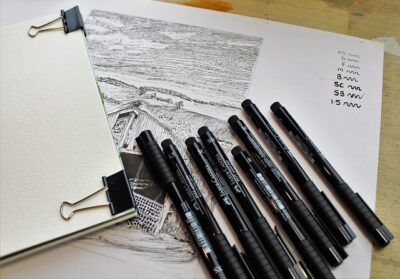
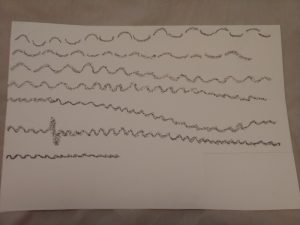 How does your breathing change in a moment of crisis? Does it become fast and shallow? Is it difficult or painful? Do you hold it in as if it is the last bit of air to ever pass through your lungs? First tightening into a knot, my chest shifts to rapid, shallow breaths, leaving little room for oxygen to pass in or out. This exercise is an opportunity to evaluate changes in the patterns of depth and duration of breaths through mindfulness techniques. After experimenting with various strokes and lines/squiggles, a wave pattern felt most natural and comfortable to me, though awkward at first. Closing my eyes made it easier to focus on my breath, getting evermore shallow as the five minutes seemed to go on for ten. Upon opening my eyes, I saw on paper the result of heading towards an anxiety attack and my inhalations increasing in number, but decreasing in duration. While this exercise shows that not every tool works efficiently for every person, the second part of this gave me the key to working on mindfulness through breathing.
How does your breathing change in a moment of crisis? Does it become fast and shallow? Is it difficult or painful? Do you hold it in as if it is the last bit of air to ever pass through your lungs? First tightening into a knot, my chest shifts to rapid, shallow breaths, leaving little room for oxygen to pass in or out. This exercise is an opportunity to evaluate changes in the patterns of depth and duration of breaths through mindfulness techniques. After experimenting with various strokes and lines/squiggles, a wave pattern felt most natural and comfortable to me, though awkward at first. Closing my eyes made it easier to focus on my breath, getting evermore shallow as the five minutes seemed to go on for ten. Upon opening my eyes, I saw on paper the result of heading towards an anxiety attack and my inhalations increasing in number, but decreasing in duration. While this exercise shows that not every tool works efficiently for every person, the second part of this gave me the key to working on mindfulness through breathing.
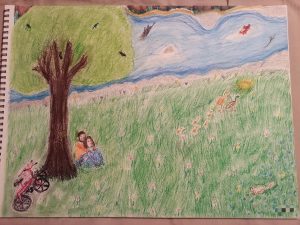 Take a moment and allow your mind to drift off to a specific location or place where you have experienced comfort. Are you by a river or stream? In the forest? In a log cabin far away from any living soul? Are you reading a book or taking a long, hot bath? Is anyone there with you or are you by yourself?
Take a moment and allow your mind to drift off to a specific location or place where you have experienced comfort. Are you by a river or stream? In the forest? In a log cabin far away from any living soul? Are you reading a book or taking a long, hot bath? Is anyone there with you or are you by yourself?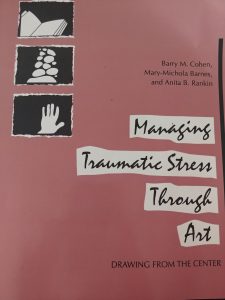 Have you ever experienced those therapy sessions where one simple phrase or question seems to blast a door wide open into the possibilities of individualized treatment that might actually work? Well, it was not my own session that accomplished this. It was my husband’s session when he told our therapist that I like to doodle and be creative and my therapist had an idea that changed everything for me in terms of personal growth and development. My therapist gave me a means of expression and processing that I had given up hope for through a book by entitled
Have you ever experienced those therapy sessions where one simple phrase or question seems to blast a door wide open into the possibilities of individualized treatment that might actually work? Well, it was not my own session that accomplished this. It was my husband’s session when he told our therapist that I like to doodle and be creative and my therapist had an idea that changed everything for me in terms of personal growth and development. My therapist gave me a means of expression and processing that I had given up hope for through a book by entitled 